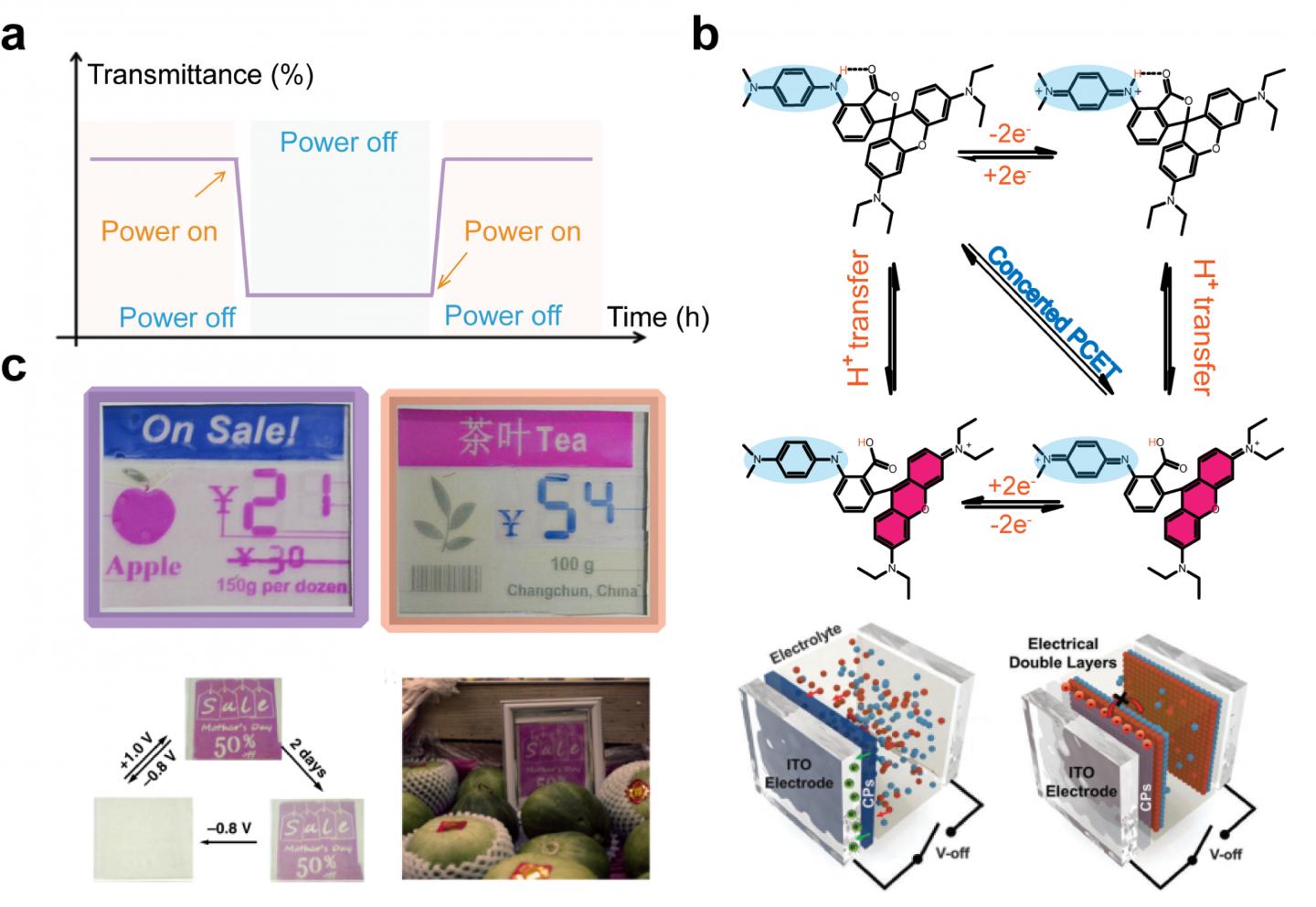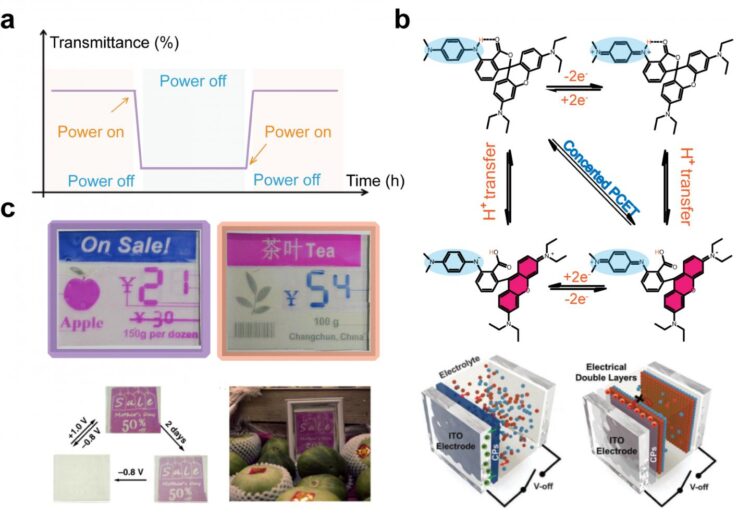
Credit: by Yuyang Wang, Hui Nie, Jinsong Han, Yaxun An, Yu-Mo Zhang and Sean Xiao-An Zhang
The development of low-energy-consumption and user-friendly electronic displays has become a long-term goal for future global sustainable development. Bistable electronic display, which requires very little electric drive to turn pages without consuming additional power to continuously display information/images, is one of the very good potential alternatives. Reflective display technologies with partial/complete bistable characteristics include e-ink, cholesteric liquid crystal, and electrochromic technologies, etc. They display information in light reflection mode, which can still be read under high-brightness outdoor sunlight and relatively dark indoor environments. It is also very friendly to the eyes, and can effectively avoid the damage to the eyes caused by the glare of traditional light-emitting display directly hitting the retina. In contrast, the bistable electrochromic materials and devices have attracted increasing attention all over the world due to their exciting advantages (such as, bright colors, wide color variation range and relatively easy preparation process, etc).
In a new paper published in Light Science & Application, a team of scientists, led by Professor Sean Xiao-An Zhang from State Key Laboratory of Supramolecular Structure and Materials, College of Chemistry, Jilin University, China, summarized new strategies to achieve more ideal bistable electrochromic systems.
Currently, various electrochromic materials have been exploited, and different bistable materials design and performance optimization strategies have been proposed, such as, the color and transmittance of the device can be changed through reversible deposition and dissolution of metal ions on the electrode surface to achieve bistable electrochromic display; the HOMO level of the redox polymer is regulated by modifying the substituent on the conjugate polymer’s skeleton, thus affecting the interface charge transfer between the polymer and the electrode, and inhibiting the spontaneous redox reaction; the bistable performance of the material can be optimized by mixing different molecules together (such as, with the structural stability of the selenium-containing polymer and the good optical properties of the thiophene polymer in the visible region); exploit indirect EC system with a new mechanism—“regulatable electro-acid/base”-induced reversible molecular color switches. It is an effective way to overcome the insurmountable technical bottleneck of traditional direct EC systems by avoiding unstable free radicals during the reaction via collaborative interactions/stabilization, and has been widely used to overcome undesirable high-energy-state/-barriers of redox molecules for various chemical reactions.
Although the bistable displays technologies have shown super-power-saving performance. It has been long-expected to enter the market as a key technology and promote the “green and sustainable development” of global society. But they are currently competing mainly at the lower end of the market. The reason is that parts of their performance (such as the speed of turning pages and the color quality/brightness) are not yet comparable to the products of the mainstream light-emitting display. Therefore, there are two ways to enable the long-awaited green electronic displays to truly meet human needs for high-quality visual experience and low energy consumption, and make them popular in the mainstream market quickly. One of the solutions is to optimize the comprehensive performance of the bistable light-absorbing electronic display so that it can meet the actual requirements of high-end displays as soon as possible. However, as mentioned above, there are many very difficult technical obstacles in this path. First, the photodegradation and oxygen sensitivity of organic materials need to be overcome. We need to go beyond traditional thinking and technological frameworks to solve this problem. Regarding the protection of dye molecules from ultraviolet light, in addition to using traditional packaging materials to absorb and block light, we can explore whether ultraviolet light can be effectively converted into visible light by using small molecules or oligomers in the EC layer or packaging materials. That is, whether such energy conversion can further enhance the color brightness of EC displays. Secondly, strategies and materials for achieving more universal panchromatic tunability remain to be further developed. Thirdly, the in-depth study of electrochromic mechanism and dynamics of existing systems are not enough. For example, the synergies in PCET reactions, the dynamic processes of electrons and ions in inorganic/organic EC reactions, the electron transfer between the electrodes and the EC materials, and other processes involved in EC reactions all require further understanding and precise optimization. Fourth, the structure of the device needs further optimized, such as the construction of a conductive layer material with controllable ion transmission, the reference of electron/hole transmission material in OLED devices, the improvement of electron transmission between the active substance and the electrode via realization of nano-scale three-dimensional electrode. We should learn in depth from nature, explore the possibility of man-made “nerve networks” systems via structural design, synthesis and molecular self-assembly and attempt to use bionic “nerve networks” to replace the current method of electrolyte diffusion for quick transfer of electrons and charges in the system.
Another solution is to revolutionize the mainstream light-emitting displays by exploiting their bistable properties. To realize this seemingly “impossible” dream, it is obvious that revolutionary technologies will need to be combined with new display mechanism design and device structure optimization. We can also adopt strategies of cross-fusing mainstream and emerging display technologies with other existing technologies (such as electrofluorescence, electrophosphorescence, controllable delay (or long-lived) electroluminescence, and indirect EC molecular switching) to give more ideal performances for future display. Integrating a variety of known or new display technologies could provide a more promising strategy and product development to satisfy various human needs, such as EC-LED/OLED dual mode systems for all-weather ultra-power-saving display technology.
“History of human development shows that the driving force behind scientific and social progress is the spirit of questioning and challenging. Many seemingly “unsolvable” problems are gradually resolved by further understanding the cause of the problem through the collaboration of science and technology workers.”
“Hopefully, this paper can allow an increasing number of researchers to understand the above scientific and technological challenges and their significance, trigger global cooperation to challenge the “impossible” scientifically forbidden zone and bring innovation in green technology to a new level.” they added.
###
Media Contact
Sean Xiao-An Zhang
[email protected]
Related Journal Article
http://dx.





